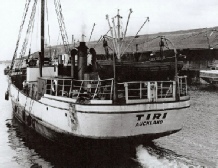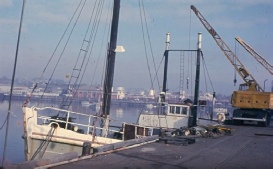© 2014-


Radio Hauraki - History (3)
Faced with all this increased speculation about planned offshore stations and the prospect of a British style 'pirate war' breaking out off the New Zealand coast the Government started to make serious noises about taking action to prevent any of the stations coming on the air. New Zealand's Prime Minister, Keith Holyoake, revealed that his Government was studying the then draft British legislation (the Marine etc. Broadcasting (Offences) Bill) and seriously considering the introduction of a similar measure.
This apparent hardening of the Government line did not stop further announcements of proposed stations off the New Zealand coast. Plans for an offshore television station were announced and another radio station, Radio International, (Radio i) was said to be ready to start broadcasts in September 1966. While the offshore television station plan seemed to have little substance, the Radio International project was altogether a more serious proposition and included an number of prominent Auckland businessmen amongst its backers
Meanwhile, Radio Hauraki pressed ahead with its own plans, still preparing to come on air by 1st October 1966 or earlier if possible. A devastating blow to these plans came in August 1966 when Radio Hauraki was informed that the ship promised by Jim Frankham, the Hokianga, would not now be available for another four months. The only other vessel Frankham could offer at that time was a 35 year old coaster, Tiri, which had been tied up for several months in a state of semi decay. Faced with mounting bills, the ever increasing threat of competition from a multitude of other offshore stations and the possibility of imminent Government legislation the Radio Hauraki team concluded they had no time to lose if they were to get on the air by 1st October 1966 and they reluctantly accepted Jim Frankham's offer of the old coaster.
coaster, Tiri, which had been tied up for several months in a state of semi decay. Faced with mounting bills, the ever increasing threat of competition from a multitude of other offshore stations and the possibility of imminent Government legislation the Radio Hauraki team concluded they had no time to lose if they were to get on the air by 1st October 1966 and they reluctantly accepted Jim Frankham's offer of the old coaster.
The Tiri was hauled into dry dock and work started to repair and convert her for her new role, with all staff, including future broadcasters, advertising personnel and the four directors of Radio Hauraki working 15- preparing the ship.
preparing the ship.
In the belief that the ship was finally ready to be issued with a certificate by the Marine Department plans were made to tow the Tiri from her berth on 17th September 1966 and for the station to come on the air officially at 11.00am on 1st October. With this date firmly set the station's DJs started recording programmes in the land-
Just as the Radio Hauraki dream was about to become a reality, the day before the ship was due to be moved from her berth the Marine Department's Auckland office informed David Gapes that the Tiri must be surveyed as a ship, not a barge and that the vessel would be detained pending a further survey as it was suspected she was unsafe.
A secret meeting was arranged between Radio Hauraki directors and Government Minister Jack Scott the following day to thrash out the latest situation. A series of deals were proposed by the Minister in an attempt to dissuade the broadcasters from setting sail -
Jack Scott then offered a compromise -
Morale at Radio Hauraki reached an all time low at this point as the various authorities continued to procrastinate on decisions relating to the survey of the Tiri and the supply of programme material to station 1YD. On 29th September 1966, two days before the station's original planned on-


Click on picture to enlarge
Tiri in her working days as a coaster

History
Key Dates
Ships and Location
Technical
Staff
Programmes









Treasure Chest

Tiri being fitted out for her new role

Back to Radio Hauraki

Back to New Zealand Gallery



